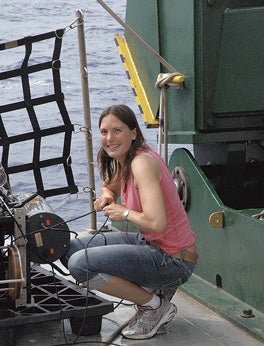Tiny Bubbles Matter
Champagne bubbles that appear to jump out of your glass and tickle your nose are exhibiting a behavior quite similar to the tiny bubbles found throughout the world’s oceans, according to bubble physicist Helen Czerski.
But while the champagne bubbles are likely to raise your spirits, those in the ocean can cause clouds to form and affect the climate.
 “Bubbles are little packets of gases that rise or fall and can be carried around as if they’re on little conveyor belts,” said Czerski, a post-doctoral fellow at our Graduate School of Oceanography. “They carry carbon dioxide and oxygen from the atmosphere down into the ocean, and then when they go back up again they pop and sulfur compounds from marine plants are sent upward, forming particles in the air that lead to the formation of clouds.”
“Bubbles are little packets of gases that rise or fall and can be carried around as if they’re on little conveyor belts,” said Czerski, a post-doctoral fellow at our Graduate School of Oceanography. “They carry carbon dioxide and oxygen from the atmosphere down into the ocean, and then when they go back up again they pop and sulfur compounds from marine plants are sent upward, forming particles in the air that lead to the formation of clouds.”
Czerski is studying how to detect and count ocean bubbles of different sizes to help scientists in other disciplines create more accurate models. She said that scientists have found it difficult to judge the effect of bubbles on their data for years and usually have had to add a “fudge factor” to account for them.
 Home
Home Browse
Browse Close
Close Events
Events Maps
Maps Email
Email Brightspace
Brightspace eCampus
eCampus


